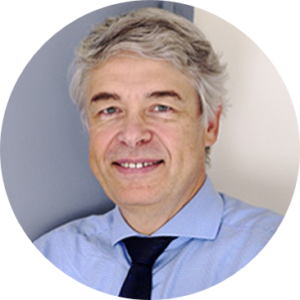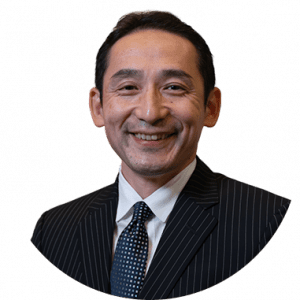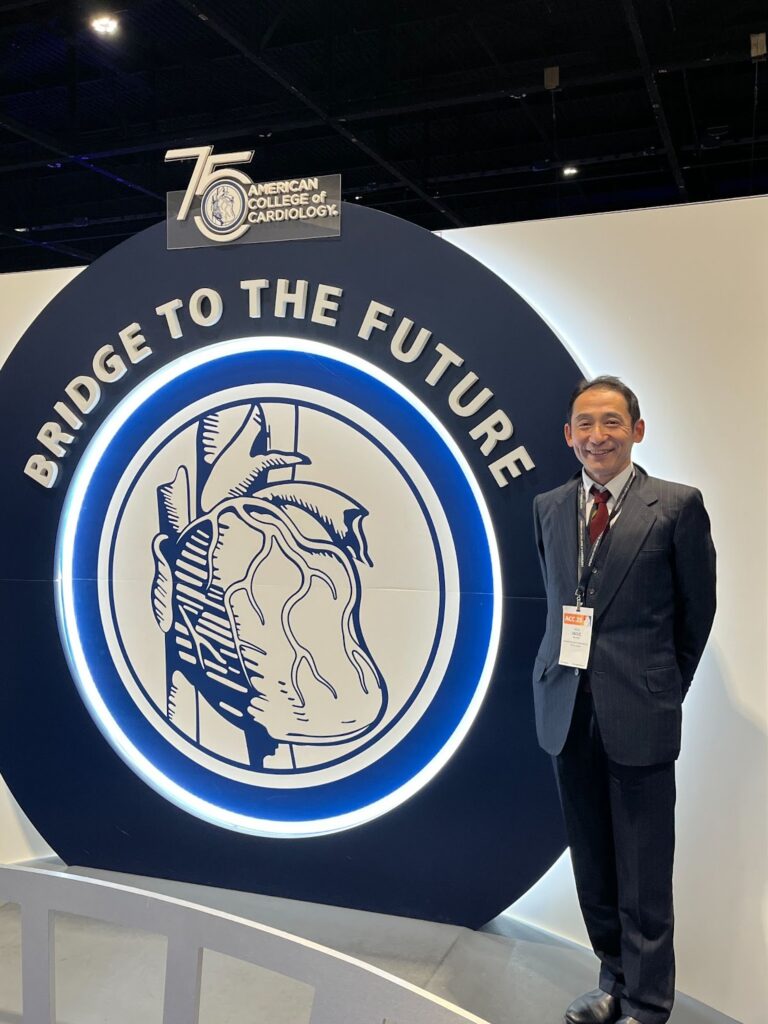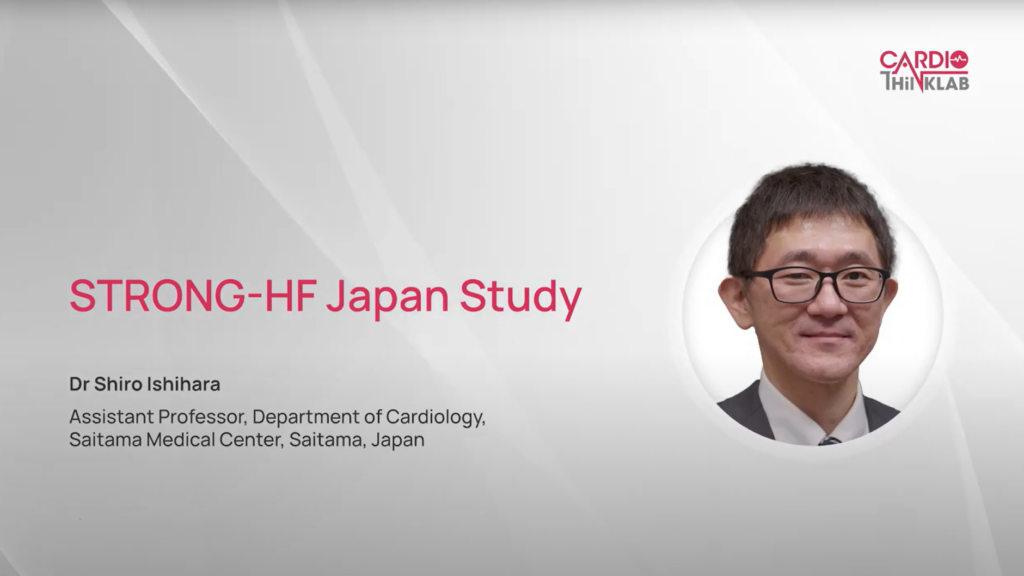STRONG-HF Japan Study: Up-titrating GDMT in acute heart failure patients
The following is a verbatim transcript of an interview conducted with Dr Ishihara Shiro on 3rd October 2024. The transcript has been lightly edited for clarity.
Transcript:
Introduction
I am Dr Shiro Ishihara from the Department of Cardiology, Saitama Medical Centre.
What is the objective of the recent STRONG-HF-JAPAN study on guideline-directed medical therapy (GDMT) uptitration among patients admitted for acute heart failure (HF)?
The number of people with HF in Japan is on the rise. In terms of the current situation of acute HF in Japan, JROAD (Japanese Registry of All Cardiac and Vascular Diseases) reported in 2013 that the number of patients hospitalized for acute HF was 85,512 people across 1612 facilities [1, data on file]. However, in 2022, this number increased to 134,943 people across 1,516 facilities, so compared with the number of patients with acute myocardial infarction in the same year, which was 77,971 patients, the number of patients with HF is extremely high [2, data on file].
However, the high frequency of patients with HF isn’t the only problem. The outcome for patients with HF is very poor and comparable to that of cancer patients, which is another urgent issue. Furthermore, there have also been reports about the relationship between the dosages of the various therapeutic drugs and patient outcomes [3]. It has been reported that outcomes improved in HFrEF patients who achieved 100% of the guideline-recommended dose of ACE inhibitors/ARBs, and beta blockers compared to patients who only achieved <50% of the recommended dose [4, 5]. According to reports investigating the dose of drugs used for HFrEF patients in Asia, including Japan, ACE inhibitor/ARB, beta-blocker, and MRA were administered in 77%, 79% and 58% of patients respectively, but the percentage of patients who received the maximum dose recommended in the guidelines was reported to be only 17%, 13%, and 29%, respectively [6].
In contrast, the 2021 ESC Guidelines for the diagnosis and treatment of acute and chronic HF recommends that patients hospitalized with acute HF be followed up early after discharge and that the dose of medication is increased. However, the evidence level for this recommendation is low and it doesn’t provide much clarity on the frequency of follow-up, the follow-up schedule, and guidance on the administration of drugs [7].
Given this context, the STRONG-HF study was conducted to assess the efficacy and safety of close follow-up and rapid dose up-titration based on guidance for patients with acute HF. It was reported that conducting a multifaceted follow-up using physical examination, HF signs and symptoms, and laboratory values, including renal function, electrolyte abnormalities and NT-proBNP levels, to assess congestion, allowed for a safe increase in the dose of heart failure medication. As a result, the number of patients who safely achieved the maximum dose significantly increased, which resulted in an improvement in the outcomes after 180 days [8].
Based on this report, the 2023 Focused Update of the ESC Guidelines for the treatment of HF added the recommendation for an intensive treatment strategy that states: ‘to reduce the risk of re-hospitalisation or death due to HF, early and frequent follow-up should be conducted after discharge, and GDMT should be started, followed by rapid up-titration of GDMT.’ This recommendation is evaluated as Class I with evidence level “B” [9, 10].
On the other hand, there’s still insufficient evidence in Japan to determine whether rapid dose up-titration can be safely performed based on the guidelines. Therefore, this study aimed to clarify whether it’s possible to rapidly and safely increase the dose of HF medications based on the guidance in Japanese acute HF patients.
Please describe the modified up-titration protocol used in the study.
When we modified the STRONG-HF protocol to create the Japanese version, we needed to take into account the differences between Japan and Europe & America. The most significant difference is the length of hospital stays. In Japan, the length of hospital stay is longer than in Europe and America. However, we felt it was important to make the most of this.
The STRONG-HF protocol states that screening should be performed 2 days before discharge, then the patients should be randomised into either the intensive care group or the routine care group. That is, the protocol is designed to immediately discharge patients once they’ve been started on the medication. This became the protocol we used to check for adverse events from the medication on an outpatient basis. STRONG-HF-JAPAN allowed us to monitor blood pressure, heart rate, renal function and electrolytes during hospitalisation.
Since there are currently almost no doctors in Japan who have treated patients using this protocol, this would help provide them with more peace of mind. In fact, this enabled us to monitor blood pressure and heart rate in real time, which allowed us to check with the patient about their symptoms as needed. This is a major advantage. Additionally, there were also changes made to the medications compared to STRONG-HF. Based on ARNI, SGLT2 inhibitor, beta blocker, MRA era, we decided to incorporate everything from the beginning. When the STRONG-HF study began, there was no SGLT2 inhibitor data available, and because it was not yet approved for the treatment of HF, it was not included in the study. So this time, we decided to incorporate these 4 pillars of HF GDMT. In addition, it was decided that there would be no switch from the ACE inhibitors in the regimen this time. This is because, when we switch from an ACE inhibitor to an ARNI, we need to pause the medication for at least 36 hours, which can be complicated. Therefore, we limited it to switching from ARBs, which doesn’t require drug withdrawal.
Another major change was in NT-proBNP. STRONG-HF requires the NT-proBNP level to be at least 2500 pg/mL at the time of screening, and at least 1500 pg/mL at the time of randomisation with a reduction of at least 10% from the screening level. This is to ensure that the patients have residual congestion. However, there are still 2 measurements that need to be taken during the inpatient period, which was cumbersome, so it was decided that the STRONG-HF-JAPAN protocol would omit the blood sampling during screening and only require an NT-proBNP level of at least 1500 pg/mL at the initiation of GDMT as a criterion.
And, of course, the maximum dose of each drug was different compared with Europe and America. For example, the maximum dose for beta blockers, specifically carvedilol, was 20mg, but in the STRONG-HF protocol, it was 100mg. Therefore, in this protocol, the maximum dose of each drug was changed to suit the actual situation in Japan.
What were the challenges of optimising GDMT to the maximum tolerable dose for your patients with acute HF?
In terms of the challenges faced when implementing GDMT at an earlier stage, I think it’s clinicians’ perceptions about it. Even those of us who planned the STRONG-HF-JAPAN study wondered whether the protocol would work and whether this would be possible. We’ve been taught by our senior colleagues that beta blockers should be started only after congestion has resolved, and increased gradually, and before we started this study, this was the routine clinical practice for our patients. There was a lot of resistance since it was completely going against what we had been doing. However, we believed that if STRONG-HF could be done in other countries, we could do it in Japan too. In other words, we needed to change our own perceptions.
And of course, we should pay attention to the onset of abnormalities in blood pressure, heart rate, renal function and electrolytes. I believe that we need to be careful when implementing this protocol for the first time. I think it’s best to start with an uncomplicated case during the initial period of implementing the protocol. It will seem difficult if you start with a very elderly patient with chronic renal failure or low blood pressure.
Also, I think it’s important to make good use of NT-proBNP. A decrease in NT-proBNP levels over time can ascertain that the condition is improving. I think this would be very useful in helping clinicians quickly and easily understand the situation. If the NT-proBNP levels appear to be increasing over time, it can indicate worsening congestion or worsening renal function.
I think the use of NT-proBNP is also very important for the safe initiation of drugs. In fact, STRONG-HF-JAPAN also uses NT-proBNP as part of the protocol to guide the titration of medications, and we believe that it has led to good results so far.
Based on your study findings, what are the top 3 recommendations you have for other APAC clinicians on implementing the STRONG-HF protocol in their institutions?
The factors that we took into account when planning the STRONG-HF-JAPAN study can be used as a reference in APAC as well.
First, I believe the most important thing is to change the perception of clinicians. Having a good tool is useless if you don’t use it.
I think it’s also very important to choose drugs that are available locally, and to set the dosage in a way that suits the local situation.
The number of blood draws, including those for NT-proBNP, and the diagnostic modalities should also be set in a way that is appropriate for the region, and I think that the frequency of outpatient follow-up visits will also be an important factor.
















